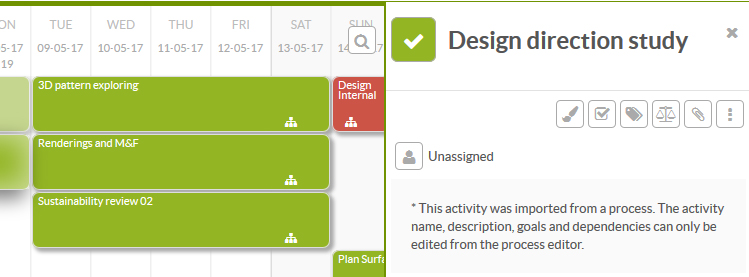If you tend to repeat projects, now you can save your planning, making it into a process to be reused in the future. You will be saving a lot of time and effort this way. You’ll just need to alter small details or requirements pertinent to the new project.
You can see it better in the Sinnaps Process Store. This is a public market in which users have the chance to publish their processes and, at the same time, choose those that best adapt to their own needs.
In this article, we’ll see the cases in which it is better to convert a project into a process and when not to do it, the benefits of creating a project from processes and how to do it using Sinnaps.
Índice
What’s the difference between a project and a process?
A project is a collection of linked activities undertaken to achieve an objective, whether a product or a service but always singular. It is temporary given there is a defined beginning and end, and therefore it has specific scope and resources. The work team may vary from project to project.
A process is a collection of linked routine activities for which various similar projects are undertaken. It comprises a methodology or procedure to follow to obtain a type of product or service. The work routine encompasses the resources and requirements to meet its objectives. The fact is the process is timeless and implanted across various projects. In a process, the team of individuals involved may vary, so the tasks are not assigned to specific people.
Now we know the difference between the two things, we can see the cases in which we should standardise our projects or convert them into processes.
When should a project become a process?
In the following cases, it is advisable to convert a project into a process. To do so, see this article: How to turn a project into a process.
— We normally undertake the same type of project.
— In manufacturing or continuous process improvement processes.
— Projects where there isn’t a high level of uncertainty.
— Highly systematic projects looking to obtain a specific result.
— When we know exactly what we want to achieve.
— When we know we’ll always have the same resources for every project.
— In construction projects where predictive methods are used.
In the end, it’s a question of applying a procedure or a series of steps which enable us to know we will obtain a particular result.
[You might be interested in the first lesson of the free project and work team management course: Which method is better? Something’s going on here… In the first class, Richard Balet, Sinnaps CEO, explains the various project and method types.]
Can we adapt processes to the new project?
The answer is ‘yes’. In fact, the processes have neither set dates nor people assigned. Moreover, we can make all the changes we need to the project based on a specific project.
Thus, we create various scenarios in Testing Mode, according to the requirements of the new project. Remember that creating a project based on a process will automatically load all the associated activities. We can change both these and the scenarios and re-think them depending on our needs once the project is up and running.
That is why when we work with a process-based project, we can reuse process activities and eliminate and create new activities.
Additionally, dependencies between activities can be added. However, remember that you can only link new activities to those inherited from the project and not vice versa.
The resources are also inherited with these processes. Thus, we have the ingredients we need to undertake a specific project.
For instance, if we need wheels to manufacture a car, the exact quantity and cost of the wheels will appear in the process. Or should we wish to publish a book, we get copy editors or editors, a writer, etc. as resources and the labour cost. From this, we can gauge the total cost inherent in a particular project, as indicated by the process.
Advantages to starting a project through a process
— We are working from a previously validated work template
— Productivity, and planning speed and effectiveness
— Incorporation of lessons learnt
— Potential subsequent problems solved quickly
How to start a project based on a process in Sinnaps
If we base our new project on a saved process, we’ll visit the Process Store to choose the process we need – whether it is ours or one published by a Sinnaps community user.

Once into the process, just click on Start Project to begin to edit our own project.

We’ll see all the activities, their durations, their links and resources necessary to bring them to fruition.
In the image below you can see a process-based project. The activities are imported and this message appears: This activity has been imported from a process. Some of the properties can only be edited from the process editor. This means the dependencies for this activity are respected. Only by going into the process editor can they be changed.
We merely have to detail the start dates, people involved and change any activity that is not necessary for our particular project.


